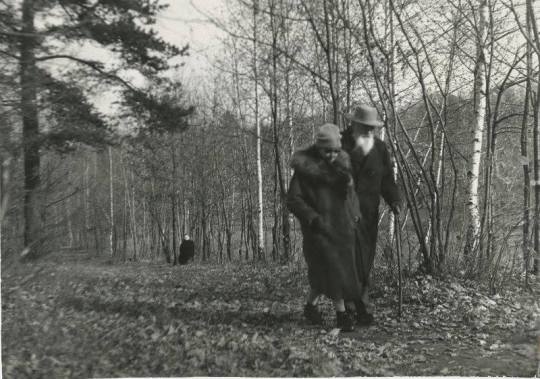The Slavic Craft is a blog dedicated primarily to Slavic Witchcraft and Magic as well as Slavic Culture, Traditions,Folklore and History.
Don't wanna be here? Send us removal request.
Text
Self love and anxiety relieving spell for client. Want a spell from me? Just DM prices are flexible. 🥰🙏
0 notes
Text
Self love and anxiety relieving spell for client. Want a spell from me? Just DM prices are flexible. 🥰🙏
0 notes
Text
Hello everyone welcome too the first blog spotlight!
I'd like too introduce you all too @sovietpostcards!

I've rebloged their content sometime. They're a very amazing blog who show off the beauty of soviets postcard. Op sells cards they personally collect as well as many other vintage trinkets. I chose this blog because they post beautiful photography of both modern and past Russia. I hope my dear readers you will decide to give them a follow and even buy something from their store.
2 notes
·
View notes
Text
TheSlavicCraft is expanding!
Hello dear readers, over the short years I had this blog, I've always been interested in creating a TikTok to show my craft and spells in video form. I will certainly be posting my video content onto this blog as well, but if interested, find @theslaviccraft on tiktok! I'll be posting spells I do for clients and showing of the workings of slavic magik. As well if you'd like to get in touch with me for help in learning Slavic witchcraft or would like to see more of my practice, you can come to the telegram channel. I do tarrot readings and spells for clients as I am, in fact, a professional witch. Much exclusive content will be on Telegram while the more consicse reaserched based content will stay here on this blog. You can always message me on Tumblr, but telegram is the best way to get updates about the blog and reach me. Hope to see you there!

0 notes
Text
ANTI-ANXIETY SPELL
By TheSlavicCraft
💕Ingredients💕
Rose Quartz/ Amethyst/White Quartz/Any other soothing crystal you have!
Purple Candle *(Note I literally use a Crayola)*
Rosemary
Lavender
Cloves
Orange peel
Chamoline
Egg shell
(Any other protecting and health indusing herbs you might like.)
Cauldron/Fire safe dishes
Himalayan Salt
White Salt
Blue paper
Blue pen
💕Instructions💕
Step 1: Take your candle and write your name on it also write any message for inner peace you'd like. "(Name) Inner peace, anti-anxiety ect"
Step 2: Place your candle in the middle of cauldron/safe fire dish. Dress it with Lavender (For easy sleep and calm) Chamoline (For pain relief) Rosemary (Self love)
Step 3: Make a clockwise salt circle with white salt around the candle.
Step 4: Write on the blue paper your name 3 times horizontally. Then vertically over the first writtings.
Step 5: Put the Himalayan Salt (For mental wellness) Cloves (For protection) Orange Peels (For joy) Is egg shell ( For protection) onto the blue paper and fold it 3 times towards you.
Step 6: Light the candle. Now burn your offering (Blue paper). Envoke the gods of your choosing. I recommend envoking Lord Apollo, Lord Hermes, and Lady Hekate. Your incantation to them is personal, but I will suggest that you ask all three deities to help you in certain aspects of getting rid of your anxiety and your mental health.
Step 7: While the Candle still burns take the crystal in your palm and put it over the flame. (BE CAREFUL NOT TOO BURN YOURSELF) Now say: The light of protection I carry is strong No ill come along No harm me or weaken my soul. I will break trough the anxiousness and conquer (reason for anxiety now thank the gods and turn off the candle.
There we go! I hope this spell helps you!
2 notes
·
View notes
Text
The Vault is finally open!
Hello, everyone. Ivana from the theslavicraft a free resource library, is finally online after a year of working on it! If you need a book about Slavic studies or Hellenism, hopefully it will be in the Vault! The vault is password protected to stop DMCA takedowns but completely free! Go to my instagram @Spaceshipfur for the password on highlights and enjoy free books!
Edit: I was made aware tha the link too the Vault was not working hopefully now it will work. Here is the link also too the highlight of my instagram with the password.
https://www.tumblr.com/thevaultowo?source=share
https://www.instagram.com/s/aGlnaGxpZ2h0OjE3OTg4NDE1Mzc2ODMxNzky?story_media_id=3674854288841019614_43743722444&igsh=MTBrbHVlcWU1cHZsbA==
2 notes
·
View notes
Text
What is Interslavic? How can we use it to better communication in the online space between Slavs?
🔅Intro🔅
Hello! Welcome to the first post on this blog! Today I ask you to come and learn about Interslavic with me and how this brilliant idea could potentially bridge the multilanguage barrier for slavs and non slavs alike!
🔅What is Interslavic?🔅
Interslavic also know as Medžuslovjansky/Меджусловјанскы is a auxiliary constructed language created by Ondrej Rečnik, Gabriel Svoboda, Jan van Steenbergen, Igor Polyakov, Vojtěch Merunka, Steeven Radzikowski in 2006. Being a constructed language means Interslavic is a language created in modern times specifically to be used allow communication between people in a related language family in our case slavonic language, to be able to communicate using one language. Interslavic is meant to be one language that is accessible and understandable to all slavs.

🔅History of Interslavic🔅
Originally all slavs spoke one language this language was shared by both Baltic and Slavic people it was called Proto-Baltic-Slavic language. While it’s a common belief all slavs spoke Ukrainian at some point before they started immigrating from the black sea. This belief is only partially correct as there where multiple proto languages that pre dated Ukrainian.
This proto language is where many Slavic languages of shoot off from such as modern Polish, Russian and Serbo-Croatian. Sadly no texts of this language have survived but instead historians used a process know as comparative method to figure out the linguistics of this ancient language. As baltics became separate from Slavs so did the languages creating Proto-Baltic and Proto-Slavic. It’s extremely interesting how these two languages shaped our 20 languages and which emerged first, we’ll breeze past this for now.
Here is a helpful guide to help keep track of the language family tree:

The idea to be able to bridge the gap between the Slavonic languages and combine them into one language again, started long ago with multiple Pan-Slavic languages (languages invented to be used by all slavs). First invented by a Croatian priest Juraj Kri��anić all the way back in 1665. Juraj named his first language “Ruski Jezik”/“Russian Language” presumably to gain favor for his language with the tzar. (note Juraj didn't invent Russian the language was named after Russian.) the language was compromised from Old Slavonic and Croatian. Most of the language was comprised of common Slavic language 59% while the rest are a small mixture of Russian, Croatian, Polish and Old Slavonic. He published his manual of the language in 1665.

Fast forward a couple of centuries and multiple other Pan-Slavic languages such as Universalis Lingua Slavica/Universal Slavic Language (by Ján Herkeľ ) are created. Jáns language was closer to the West Slavic languages than Juraj’s. Which comprise of Czech-Slovak, Sorbian and Slovenian.
Both Ruski Jezik and Universalis Lingua Slavica gained notoriety by their creators peers in socialist circles the main focus was too use these two languages as a helpful translation tool rather than a live language, thus once the creators of the languages died or stopped using them they died out and faded into irrelevancy. The two previous languages were confined to already academic circles.
The struggle to create a real working Pan-Slavic language is a issue that has lasted centuries. Scholars from both Yugoslavia and USSR tried their hardest to come up with a reasonable system for a shared language between the two nations which subsequently failed once both USSR and Yugoslavia fell apart and the south Slavic regions became less enthusiastic about using Russian as a common language. Russia has always been pro having a Pan-Slavic language mostly by Russian Pan-Slavists, one look at the USSR's history shows thee Russians willingness to have a unified Slavic state. Though the idea never quite gained traction or much popularity among the smaller Slavic nations. Slavs are proud people they don't want to be viewed as a another smaller subsect of Russia but as their own unique independent nations. Russian is not a simple language it is extremally hard to master. It has numerous features that make it hard to for other Slavic people to understand the language. These factors made it unappealing to adopt as a "one for all' language.
The 21th century, we witness a shift from solo projects towards collaborative projects that could be shared all around with the power of the internet to numerous people. The internet age meant that the developers of Interslavic no longer had to work in isolation but could get feedback and suggestions of many slavs all around the world!
The first collaborative project was named Slovo but was discontinued after being active for 2 years between 2001-2002. It then evolved into the Pan-Language we know now Interslavic. The major plus of a collaborative project was that many people can contribute with their own perspective and knowledge of several different slavic languages. The collaboration of multiple writers and scholars resulted in the creation of the first Pan-Slavic dictionary. This new approach to the creation of a Pan-Slavic language meant that the language already had a devoted userbase at its exposal then other language who had to compete to create one.
Finally we are in 2006 where the creators of Interslavic had a different approach in creating their Pan-Slavic language. They wanted to create an actual live language instead of one that would only be used for translations. Starting in march of 2006 the project was originally named Slovianski created to developed by Polish-American Steeven Radzikowski, was merely intended to reform Slovio, but gradually it developed into a separate language. Slovianski had then helped develop Rozumio (2008) and Slovioski (2009) were both efforts to build a bridge between Slovianski and Slovio another popular Pan-Slavic language.
Originally the language had two versions Slovianski-N and Slovianski-P. (N stands for naturalism, P for pidgin or prosti "simple"), Slovianski-P was a simplified version of the former and had prepositions like Macedonian and English while Slovianski-N had six grammatical cases. At one point there was a 3rd iteration of the language known as Slovianski-S it was a schematic version of the language, this version was only used in early stages of the project. In 2009 it was decided that only the naturalistic version would be continued under the name Slovianski. Slovianski used 3 genders (masculine, feminine, neuter) the gendered parts of the language were heavily simplified full conjugation of verbs—features usually avoided. The internet had let Interslavic reach a far wider audience than its predecessors both slavs and non slavs alike.
In 2009 a new language was published, Neoslavonic ("Novoslovienskij"/ "Novoslověnsky") by Vojtěch Merunka, based on Old Church Slavonic grammar using parts of Slovianski's vocabulary.
In February and March 2010 Slovianski would appear in articles on the Polish internet portal Interia.pl. On the site the language would gain traction and would be featured in many other publications such as, the Serbian newspaper Večernje Novosti and Slovak newspaper Pravda, Czechs news site of the broadcasting station ČT24 and would even appear in multiple versions of the Readers Digest.
Two years later the in 2011 the two languages combined into one finally forming Interslavic (Medžuslovjanski). In the same year Slovianto was formed. Slovianto was is a highly simplified version of Interslavic meant to be used by non-slavs as a introduction too slavic languages. Slovianto has three intended stages of complexity: level 1 with plurals, tenses, basic vocabulary; level 2 with grammatical gender and basic verb conjugation; and level 3 with noun declension.
June 1-2 of 2017 the first ever conferenced of the Interslavic language (CISLa 2017) commenced in Staré Město, Czech Republic. The conference was apart of the bigger event, The Festival Days of Slavic Culture. 12 different countries participated in the conference with an outstanding number of 64 participants. This festival was the first event is the first time that Interslavic was used officially at a public event. Marking a major landmark in the history of the language that by now surpassed all its predecessors. Most panel media such as presentations where held in Interslavic or translated it into the language. This turned out expediently for all Slavic participants including Poles and Bulgarians to understand everything. Making the it clear the success of Interslavic. According to the official the Interslavic website, people who did now even know how to speak Interslavic learned enough of the language during the conference that they become to begin to speak some of it during the conference.
Jan van Steenbergen the creator of the language Wenedyk and Vojtěch Merunka the co-author of Interslavic decided too unite the two languages during the conferences. After the conference the two man formed a committee of three fluent speakers of Interslavic.(Roberto Lombino, Michał Swat and Pavel Skrylev), whose task it was to detect and eliminate all differences between the twos grammar. By July the task had been finished. After the merger, the name of the language became Medžuslovjansky. Same year the scientific journal Slovjani.info was created. The journal was made up of various articles written in Interslavic.
The next conference took the May of 2018 which the team behind Interslavic once again participated in the Czech Republic. This time the participants grew from 64 to 67. In the same period, Interslavic was presented at several international conferences, in Podgorica, Poznań, Łódź and Moscow.
The critically acclaimed film "The Painted Bird" based on the book by Józef Lewinkopf was released on 3 September 2019. (a day after my birthday lol.) The release of this movie was an incredible fleet for Interslavic as "The Painted Bird" was the first ever movie released in the Interslavic language. The director Václav Marhoul commented that he decided to direct the movie in Interslavic because he wanted no Slavic nation nationally identify with the story. A choice I find endlessly fascinating, we'll definitely have to go over "The Painted Bird" in more detail on this blog!
🔅How can Interslavic help the slavic community?🔅
Interslavic helps our community in tremendous ways creating one large languge that fosters cultrual exhange. Unlike national languages that carry political or historical weight, Interslavic serves as a neutral tool for communication, free from national bias. This neutrality makes it especially valuable in multicultural or politically sensitive settings where using one national language over another could cause tension. It also plays a growing role in online communities, forums, and cultural projects, enabling Slavs from different countries to collaborate in music, literature, and film. While its simple learning curve ensures the learners of the languge are able to adapt faster to it then learning other slavic languges. I encourage all my readers to attempt to learn interslavic.
#Interslavic#slavic culture#eastern slavs#balkan#central slavs#western slavs#the painted bird#slavic#slavs
5 notes
·
View notes
Text
🏵️Remembrance Day Post🏵️
Notes Translations Steam
Hello everyone good day! Whole this post is a little overdue I didn't want to neglect making a remembrance day post. I feel like it's a very important to uphold and honor our ancestors and veteran's who fought for our many freedoms, but to also applauded the multiple man and woman who bravely fight for our freedoms and countries today. This is why I've chosen to focus this years Remembrance Day Post on the solider fighting the war in Ukraine.

Since February of 2014 Russia has been increasing it aggression towards Ukraine escalating into a full on invasion in the recent past of February 2022. Russia annexed Crimea in 2014 and established two puppet states (or a Russia likes to call them: republics). Donetsk People's Republic (DPR) and the Luhansk People's Republic (LPR) The two republics were originally wanting too split of Ukraine due to pro-russian sentiments in the region and were quickly funded by Russia to go to war with the rest of the Ukrainian nation with Russia sending its own armed forces into regions but adamantly denying it. This conflict escalated into the violent Donbas war. In February 2015, Russia and Ukraine signed the Minsk II in agreements to end the conflict. The two nations never fully implemented in the years that followed. It was clear that both countries were still in a extremally tense state. Rightfully so on Ukraine's part as they were unable to gain back the now occupied russian territory. The Donbas war settled into a static conflict between Ukraine and Russia and separatist forces, with many brief ceasefires but no resolvent in the conflict and few territorial control changes.
In the beginning of 2021, Russia built up a large military presence near it's border with Ukraine within the neighboring Belarus. Russian officials repeatedly denied plans to attack Ukraine. Of course this was a lie and Russia invaded Ukraine in the February of 2022. Since then the two countries have been at a brutal war. There is hope that the war will end soon! Oleg Zhdanov is a former Ukrainian military officer has suspected that the war will end as soon as the spring of next year. Experts from the Atlantic and CNBC predict that the war will end in 2024 or at least prolong one year afterwards in the worst case scenario.
Today I would like to introduce you to a man, Vladimir "Fresh" Yezhov. A brave man that like many many in his nation has died fighting for the freedom of Ukraine. Vladmir was one of the developers of the hit and most anticipated games "S.T.A.L.K.E.R 2". He wasn't the first STALKER developer to fight actually, multiple of the game dev team are fighting in the war while also working on the game. (Incredible I know!)

youtube
The game studio The GSC Game World released the dev diary above on Jun 14, 2022 showing their life before the war and how everything changed in Kyiv when Russia attacked. While most of the team was able to safely evacuate to Czech Republic some of it's members weren't able to leave and stayed to fight. The video shows at 2:30 just shy of the end of the video Vladimir "Fresh" Yezhov colleagues who too decided to join the army. Dmytro Iassenev the studios lead AI developer. Who tragically comments "I would have never expected to witness a war in Europe in the 21st centaury." (It is quite tragic how the ghost of our pasts have come to haunt us, yes. I agree with Dmytro fully.) Oleksii Ivanov the Community Manger and Maksym Hnatkov Narrative Designer are shown in the video supporting their country. Slava Ukraine! <3 The STALKER team has been hacked and constantly harassed from Russians on all sides, but none of these aggravations are able to stop them. The game is still on a steady way of being released. I hope you will all go and support them on their release trailer and steam page. (Go wishlist S.T.A.L.K.E.R 2 and save up for this damm game the people that are making it deserve your money!)
youtube
Vladimir "Fresh" Yezhov became a commander of an air reconnaissance unit in the 23rd Special Purpose Battalion. He was one of the first ever recorded from the defense team in the initial invasion of Ukraine. Vladimir died bravely defending Bakhmut, a city in Eastern Ukraine that has been under assault since May. He left behind two wonderfull angel boys who I'm sure will be extremally proud of their father. a leader of a Freedom faction detachment In his memorial One of the game's characters, Loki, featured in STALKER: Call of Pripyat was based on Yezhov's likeliness.
To the remaining developers of The GSC Game World I would like to close off this post with a message to you, You are all incredibly brave and are all heroes to the people fighting or not. I give you my greatest condolence's to your loved ones who might have fallen in service. Their heroism and ultimate sacrifice will never be forgotten. I can relate to you in many ways, my home country of Croatia was only 30 years ago bombed and attacked as well but Croats have thrived since then immensely. Ukraine will thrive again your beautifully home of Kyiv will be restored to its former glory one day, as well as the rest of the glorious Ukraine. May the Gods protect you as you fight the good fight. Let's no forget all the other solider who just like Yezhov's have died in service to protect the country their scrafise is just as celebrated as the living who go on fighting.
Least we not forget Slava to Ukraine!
youtube
#s.t.a.l.k.e.r.#s.t.a.l.k.e.r shadow of chernobyl#slavs#ukraine#russia#ukraine war#stand with ukraine#Vladimir “Fresh” Yezhov#The GSC Game World#Youtube
3 notes
·
View notes
Text

A walk in the park. Photo by Igor Stomakhin (Moscow, late 1980s).
155 notes
·
View notes
Text
🍬Slavic Halloween🍬
Hello everyone! Here is my sweet treat for you today I've decided for Halloween I'd post a special Halloween posts to celebrate enjoy! <3
You might be shrugging reading the title slavs celebrate Halloween? Yes we do!, Many slavic nations celebrate Halloween from western Croatia all the way to all the way to the east in Russia slavs have many rituals and traditions for Halloween. Let's dive into slavic Halloween!
🍬Bulgaria🍬
Halloween in Bulgaria is very popular. Children and younger people in the cities do celebrate Halloween and go trick or treating. «почерпка или пакост» (pocherpka ili pakost). Unlike in the rest of slavic countries candies and decorations for Halloween are sold at popular retailers Lidl and Kaufland. (For my western audience those two stores are like Costco and Walmart for the balkans). Clubs in cities will have special events for Halloween for older people who aren’t out trick or treating just like in western nations.
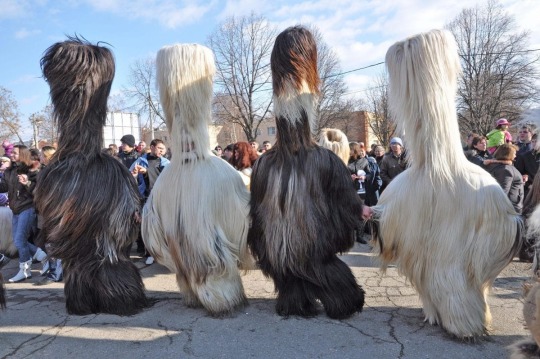
Halloween is associated in Bulgaria with a old traditional carnival called Surva. During the festival the “Kuker’s game” is preformed. Kukeri are elaborate costumes made by Bulgarian man who perform traditional rituals intended to scare away evil spirits. Their costumes are meant to signify the connection between man and nature and they wear their traditional Nošnja underneath. The Kukeri coustomes are large and imposing to scare away evil spirits who threaten the people of the Kukeris village.
This tradition is extremely old dating back to 6 AD to Thracian times. You can draw comparisons to this tradition and how Halloween was celebrated originally to ward of evil spirits when they crossed to our world during the solstice.
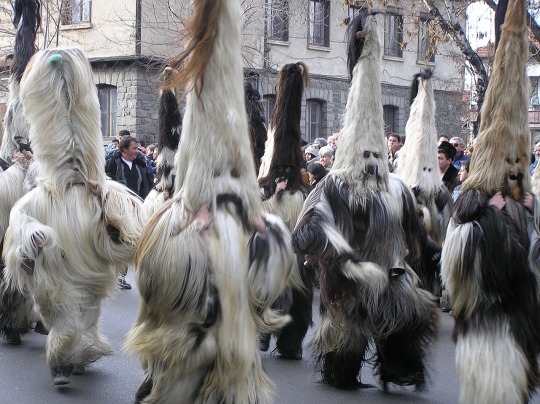
Kukeri could possibly come from the Proto-Slavic word kuka ("evil spirit") with the agentive suffix *-aîb, literally meaning a "chaser of evil spirits".
The custom is widespread in Southern and Central regions of the country. The festival also includes a hearty feast and many performances by the Kukeri and their female counterparts. The woman also wear very elaborate incredibly beautiful masks and Nošnja as well as traditional leather tsarvuli for shoes in the parade.

Both woman and man will participate in elaborate staged fights between the powers of good and evil during the festival and while parading in their village. There’s one more type of performer they are called Survakar who too have their own special costume. They look like the monsters from “Where the wild things are”, they come behind festival goers and cleanse them from evil by tapping them on the shoulder with a thin branch. These branches are decorated with assortments of all types of beautiful things like ribbons, silver/golden coins and flowers. All these things signify the sender giving you riches and blessings when they cleanse you. The festival night will end of with the feast of many traditional dishes like, kebapcheta and kyufteta (traditional grilled sausage and meatballs), the cheesey and buttery pastry banitsa, and extreme amounts of plum brandy. (You can tell their balkan lol.) The masked personal guiding the spirits away from the village in the night with lit torches.
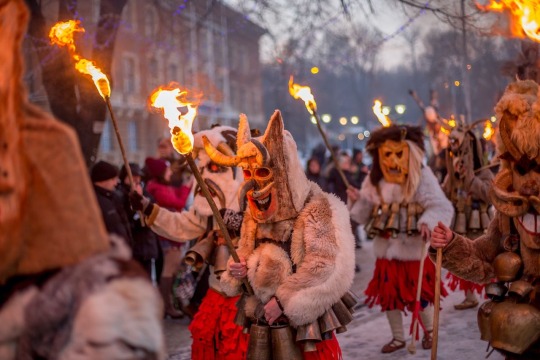
🍬Bosnia i Herzegovina🍬
As you might know most of Bosnia's population is of muslim divinity. So, the celebrations of Halloween is not very popular in this country. The country does not consider Halloween a public holiday but a minority of people still celebrate it. In Bosnia the holiday is not called Halloween but "Noć vještica" (Night of witches') the same as in Croatian and Serbia. The celebration of Noć vještica is much more western in Bosnia than other balkan & slavic countries. With customs, face paint, many pumpkins and parades. You will notice in most slavic countries children especially young ones, don't necessarily have "graphic" or "scary" costumes'. They usually have sweet non scary customs like seen in the parade. I remember as a child too I was not allowed to dress as anything scary and my parents drew the line at a witch because that already was "too dark". (hahaha I bet some of my western audience is reading this thinking "but that's so vanilla!") In slavic countries the western tradition of "trick or treat" is not very common or used. Instead children will carry a sack and be given candy during the parades. It seems that in Bosnia Noć vještica is a holiday only popular with children and seen as more of a "joke holiday" for children to have fun and not taken seriously.


🍬Croatia/Hrvatska🍬
In Croatia Noć vještica is a much bigger deal than it is in Bosnia. But I feel it's quite controversial it seems to make many people uncomfortable. Croatia is by far one of the most religious' of the slavic country more so than Poland or Bosnia I'd argue. Most people aren't extremally happy involving themselves with things that are associated with demonic presence or black magic like Halloween is. Croatian Noć vještica usually incorporates a parade of the drowning of Marana. A ancient ritual in slavic tradition. Slavs believed that burning an effigy of the goddess of death (Morana) would remove any results of her presence (i.e., the winter) and thus bring about the coming of spring. On Noć vještica Maranas effigy is burned instead of being drowned like in other cultures. This practice had seemed to be forgotten I'm sure that if you even asked a older croat they wouldn't have known who Morana is. The ritual is often confused with a similar ritual of L'Hom Strom. This tradition I observed as a young girl in my grandmothers village of Kozarac, Croatia. Once when I was 6 I spent Halloween with my grandmother. I got my witch custom and we went into the town square to celebrate with the other children. The straw effigy was incredibly big maybe around 20ft tall it took multiple man to carry it on a stick. It was paraded trough ought our village as we marched and sang. Once the effigy had seen the entirety of the village we went to the giant parking lot behind the city hall and burned the strawed effigy of Morana. The image shown bellow is not of the same effigy or practice I witnessed as a child but I felt bad of not showing you a visual. ;)

The one I had witnessed in Kozarac was way less detailed than this one it looked far more like a simple straw doll.
Croats have many traditional carnivals all over the country. That are very similar to modern Halloween! The carnival in Rijeka is Croatias most famous carnival it’s held in many different cities trough January 17- February (date varies) Rijekas festival also includes a child parade where children dress and ask for candy.
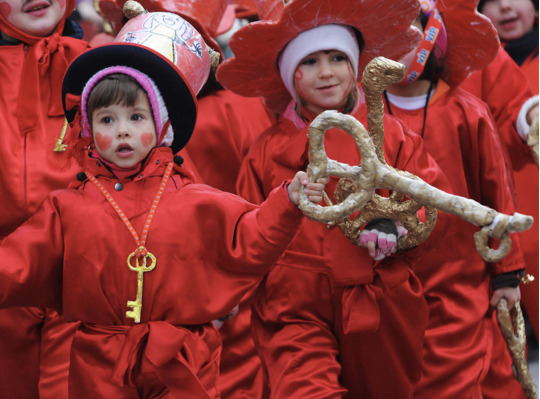
One that you might have seen pictures of before are the sheep headed masks that are worn at this festival, their quite distinctive! In Opatija people will dress in sheepskin and hides for their parades the costumes are named Zvončari ("bellmen"). Just like the traditional celebration of Halloween the belief long ago was that dressing up as a demonic creature would deter and hide you from evil spirits crossing into our world. The people that chose to participate will often decorate themselves with bells small or big and with ribbons. Parading in a long complicated and jovial dances immolating a flock of sheep. This tradition was included in 2009, on the UNESCO list of Intangible Cultural Heritage.
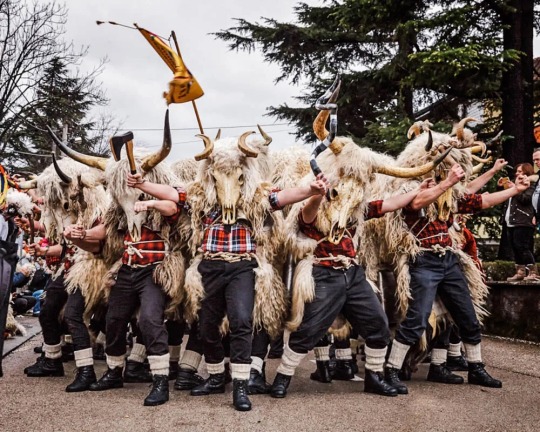
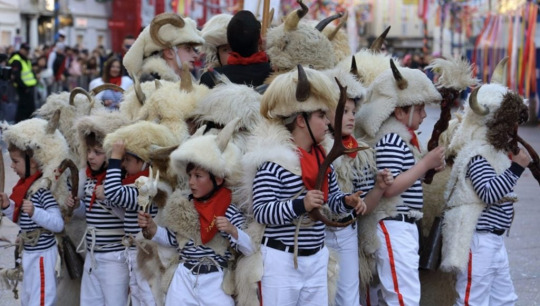
Croats traditionally celebrate Sve Svete (“All Saints Day”) on the day of Halloween.
🍬Serbia🍬
Serbs love Halloween! Out of all the slavic country I would say that they’re the most receptive to it. Serbs fully embrace the western tradition with creepy costumes, trick or treating Смицалица или посластица (Smicalica ili poslastica) and tons of partying! Both children and adults alike celebrate Halloween in Serbia. Both in major cities and in villages. Belograd seems to love to celebrate Halloween with most clubs throwing o parties and events for people too old to trick or treat. The holiday has been celebrated in Serbia for a while now, the oldest post I could find about a bloggers experince of Halloween in Serbia was 2011 and even in the distant past the blogger was very casual about their celebration of the holiday in the country.

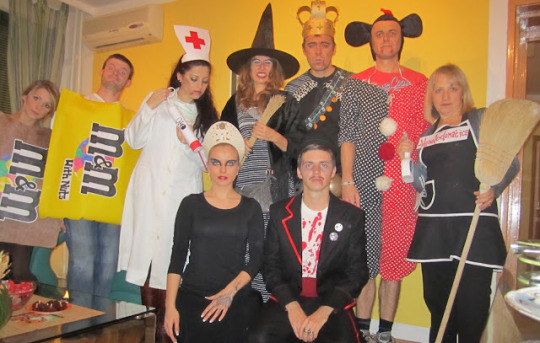
Serbia also seems to have a traditional festival like Croatia and Bulgaria similar to Halloween. But for the love of Lady Athena I could not find much information online besides some pictures!
Here is my brief proof that the festival even exists:

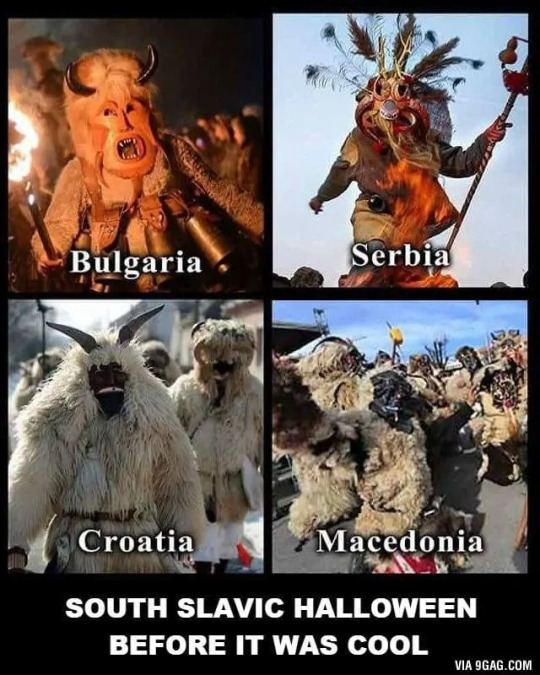
This concludes this year’s Halloween post! Hopefully you’ve learned something new and interesting about slavic traditions regarding Halloween. I hope you will join me next year too when we dive into more ways that the slavic nations enjoy themselves for the spooky holiday. Have fun trick or treating tonight everyone! <3
#slavic culture#slavic folklore#slavs#croatia#serbia#bulgaria#bosna i hercegovina#balkan#balkans#halloween#slavic halloween
11 notes
·
View notes
Text
-Blog Introductions!-
🍃Introduction🍃
Hello! My name is Ivana I'm a Croat currently living in Canada. I'm 18 years old, I'm a writer trying to kickstart my career on my main blog that's currently inactive @lesiocara, I've been a folklore dancer for 3 years and I used too dance with my group across the USA and Canada.
🍃Purpose of Blog🍃
I started this blog because I noticed a lot of cognitive disconnect between immigrant Croats and main land culture. I felt like there wasn't enough resources for younger immigrants to truly understand or experience their cultures in a authentic way. And I noticed much deference between myself and my peers who always have lived in Canada. As they didn't have much ties to their own cultures. This is slowly becoming a growing concern to me back home too as many other southern/central Slavic countries embrace western ideals more and more many of us are starting to lose our ties to our cultural heritage as Slavs. This is why I started this blog to help immigrants and even mainlanders who wish to connect more to folklore and heritage of their countries find resources and paths to reconnect to their heritage. This blog primary shows off Balkan Slavic tradition but I strive to showcase all Slavic countries and cultures on this blog.
🍃Rules of the Blog/DNI🍃
Please, do not interact with this blog if you'll express bigited or hateful views on my platform or comments. This blog is not a safe space to be prejudice, xenophobic, nor racist towards any group. I do not tolerate seeing Croatophobia, Anti-Serb sentiments, Russophobia or any other sort of Anti-Slavic sentiments towards any other Slavs or claims of superiority over any other nationality's /groups on this blog. You will be warned to tone it down if I find your comments offensive or downright blocked.
Rules
No homophobia, xenophobia, religionism (antisemitism, islamophobia),racism, transphobia ect ect.
No use of any slurs especially of racial slurs like gy*sy or esk*mo. Both Romani and Inuit/Yupik cultures consider the two words up above as slurs against them and are not allowed to be used outside of historical context on this blog. This rule applies to the two terms of Ustaše and Chetniks as the two are often used as slurs towards Croats and Serbs.
This blog is a safe space for all slavs and is here to uplift all cultures, we will be discussing both past and current wars but I encourage you to use your critical thinking skills and realize that not everyone of a certain nationality can be blamed for that groups actions in wars. I do not tolerate seeing Croatophobia, Anti-Serb sentiments, Russophobia or any other sort of Anti-Slavic sentiments towards any other Slavs or claims of superiority over any other nationality's/groups on this blog.
If you would like to submit a post please link the sources. Such as texts and copyright holders you got the information from. Its so easy for people to fake things and claim they are backed up by tradition especially when discussing Magick. It's perfectly fine to link yourself as a source on information just be extremally clear about that.
No bible thumping! Please respect everyone's right to their own religion. Don't go under posts that discuss Magick or Rodnovery and comment things like "jesus loves you." or bible verses about how pegan's are going to hell or smth. Please don't attack other religions ether. Slavs are very diverse we come in all shapes and sizes some of us are catholic, jewish, orthodox, muslim or even pegan so please understand and respect the fact that not everyone follows your religion.
I do not support any extremist groups left or right leaning. Uses of covert phrases or dog whistles are not allowed on this blog. I will not platform or put a positive light on extremist groups like Ustaše, Chetniks, UPA, Neo-Nazis (Slavic Union,S14) or any other similar groups.
This blog is at least 16+. We discuss multiple facets of Slavic history on this blog. As you are probably aware Slavs have a very tremulous history. There will be graphic content on this blog appropriately censored to comply with tumblrs guidelines that people still might find disturbing. The history posts will have trigger warnings listed above the article viewer discretion is advised.
Post submsions can be in ether serbian, bosnian, croatian ,czech, english or interslavic as those are the only languages I understand. This is so I can fact check you. If you want to submit but do not know these languages just DM me so we can work on a translation together.
Post submissions must be tagged with a post group on this blog (see bellow) and if your writing about a historic event you too must include trigger warnings at the top of you're post.
🍃List of Resources🍃
T/BA
🍃Asks/Dm's/Post Submits🍃
This blog is only made possible by the hard work of various people in our community researching and compiling knowledge about Slavs in multiple languages and media. I'm no expert on all things Slavic I'm nether historian or culturalist I simply do my own research and present it on this blog. Please if you are willing link articles, textbooks and other research in other languages if you can. I will need help with translating resources while I might not be able to pay you much I am glad to work out payment for help in translating various media. You can DM at any time about anything you'd like tho, unless you're reaching out for something personal or a translating job I'd prefer you use the asks feature. Post submissions must be in one of the categories on this blog and must be related in someway to slavs. They also must be in serbian, bosnian, croatian ,czech, english or interslavic and you must link/credit you're sources.
🍃Post Groups/Posting schedule🍃
Slavic Witchcraft & Magick
Slavic Culture
Slavic Traditions
Slavic Folklore
Slavic History
Resource Find
Blog Spotlight

Note: This blog isn't updated daily it would be impossible for me to upload accurate well researched posts to you on a daily basis. Instead this is a guide as to what subject I will be posting on what day of the week.
Thank you for reading I hope you'll enjoy the blog :)
#slavs#slavic witch#witchcraft#slavic paganism#introductory post#croatia#serbia#slavic culture#slavic folklore#introduction#blog intro
14 notes
·
View notes
